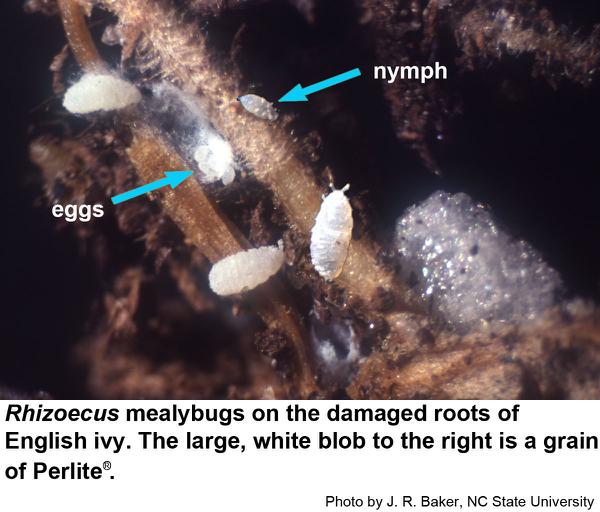Description and Biology
Root mealybugs in the genus Rhizoecus have adapted to subterranean life. These include the ground mealybug, Rhizoecus falcifer, Rhizoecus americanus, and the newly introduced hibiscus mealybug, Rhizoecus hibisci. One of the most familiar root mealybugs in North Carolina is Pritchard's mealybug, Rhizoecus pritchardi, that feeds on the roots of African violets and other plants. These root mealybugs differ only in microscopic characters. Adult females are 1/16 to about 1/8 inch long, slightly flattened, and rounded on each end. The body is bluish white but covered with a shallow, white, fluffy bloom. They resemble large, white springtails but move much more slowly. Some species even secrete slender filaments that form a netting over the insect. They also secrete a powdery, white fluff that gives the soil a bluish tint. These mealybugs almost or completely lack eyes, and the antennae are short. Females lay at least six eggs in a fluffy, white sort of nest. The nymphs resemble females but are smaller. When potted plants are irrigated, root mealybugs sometimes crawl out of the drainage holes and infest plants nearby.
Host Plants
Root mealybugs feed on the roots of ornamental plants including Achillea, Arctostaphylos, African violet, anemone, bamboo, Bermuda grass and other ornamental grasses, chrysanthemum, Geum. ginger, gladiolus, iris, hibiscus, Polygala, Robinia, and palms including queen, majesty, fishtail, triangle, kentia, lady, pygmy date, and MacArthur palms. These mealybugs can be found feeding on the roots of many plant families.
Residential Recommendations
Because mealybugs are susceptible to systemic insecticides, I recommend treating infested plants with imidacloprid or some other systemic insecticide. Most of the systemic insecticides found in big box stores and garden center should be effective as long as they are labeled for residential use. Some formulations of systemic insecticides are labeled only for landscape use. Houseplants can be placed outdoors for treatment with such labeled insecticides. Tender houseplants should probably be placed in shade to prevent sun scald.
References
- A Revision of the New World Mealybugs of the Genus Rhizoecus, (Homoptera: Pseudococcidae). Hambelton, E. J. 1976. USDA Tech. Bull. No. 1522.
- Mealybugs of California. McKenzie, H. H. 1967. University of California Press. Berkely and Los Angeles. 525 pp.
-
Insect and Related Pests of Flowers and Foliage Plants. Baker, J. R. ed. 1994 (revised). NC Cooperative Extension Service pub. AG-136.
-
Rhizoecus hibisci. Hara, A. H. and R. Niino-Duponte. 1999. Crop Knowledge Master, EXTension ENTOmology & UH-CTAHR Integrated Pest Management Program, R-HIBISC.
-
Root or soil mealybug (Rhizoecus hibisci). von Ellenrieder, Natalia. 2003. California Department of Food and Agriculture.
- Extension Plant Pathology Publications and Factsheets
- Horticultural Science Publications
- North Carolina Agricultural Chemicals Manual
For assistance with a specific problem, contact your local N.C. Cooperative Extension center.
This Factsheet has not been peer reviewed.
Publication date: Feb. 22, 2018
Revised: Dec. 2, 2022
Recommendations for the use of agricultural chemicals are included in this publication as a convenience to the reader. The use of brand names and any mention or listing of commercial products or services in this publication does not imply endorsement by NC State University or N.C. A&T State University nor discrimination against similar products or services not mentioned. Individuals who use agricultural chemicals are responsible for ensuring that the intended use complies with current regulations and conforms to the product label. Be sure to obtain current information about usage regulations and examine a current product label before applying any chemical. For assistance, contact your local N.C. Cooperative Extension county center.
N.C. Cooperative Extension prohibits discrimination and harassment regardless of age, color, disability, family and marital status, gender identity, national origin, political beliefs, race, religion, sex (including pregnancy), sexual orientation and veteran status.

